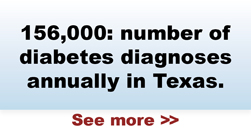Editor's Note:
There are a number of ways people access tickets to health care: private insurance, government-subsidized programs, charitable care, or cash. Yet even as policies are changing the way we distribute tickets, the overall health of central Texas is not going to improve if there aren’t enough providers to punch those tickets.
While Texas’s population has increased steadily, our total number of doctors has changed very little in the last 25 years. Of the top six most populous states, Texas is only fourth in the number of medical students and the number of physicians in training (resident physicians) per capita and the lowest in the number of physicians per capita.
In this article, Patricia Young Brown, CEO of Central Health, discusses the impact this provider shortage will have on the health of our community and access to care for all central Texans.
Austin has a healthcare-provider shortage that will worsen dramatically over the next ten years if nothing changes, affecting health care’s quality, cost, and accessibility for all of us. And this will affect not only those who have private health insurance, but also those who may qualify for Medicaid, as well as over 67,000 current Medicare beneficiaries and the tens of thousands of people who will age into Medicare in the coming years.
Comprehensive health care that will support a healthy community requires a primary care foundation, including preventive care, and takes a holistic view of patients so that the emergency room is used for just that: emergencies. Without a foundation of accessible primary care, health indicators are poor, and cost of care goes up. This foundation must also be supported by a diverse network of specialty care. Specialty care is necessary to help patients manage and overcome more acute or ongoing conditions.
A May 2009 report by the Seton Family of Hospitals found that central Texas will be short 3,000 physicians in 10 years. The largest gaps will be in primary care (family practice, internal medicine, and pediatrics) and in certain medical and surgical subspecialties such as pulmonology and psychiatry. Data show that Travis County has 2,853 physicians for a population of over one million; only 37 percent of those provide primary care. The state of Texas currently ranks 45th in the number of physicians per capita.
Recruiting primary care physicians is critical. But the provider shortage problem trickles down from primary care to specialty care. Central Texas has only a handful of pulmonologists. You can wait six months to see a psychiatrist, even with private insurance. There are only two pediatric endocrinologists in central Texas.
If Austin is so cool, where are all the doctors?
Austin is a city where everyone seems to want to live, so why would central Texas have a shortage of providers? First, many people do want to live here, and our population growth has been dramatic and rapid. Austin has more than doubled its population in the last 20 years. Like our traffic and housing needs, our health care needs have grown so fast that we have not been able to keep up with demand.
Second, Texas certainly sees a brain-drain problem with the medical students we invest in who attend one of our eight medical schools but do not end up practicing as providers in the state. In fact, we lose over 40 percent of those future providers to other states. There is a limited number of Graduate Medical Education (GME) or residency placements in Texas. We know that of the providers who do both schooling and their GME in Texas, nearly 80 percent stay here and care for Texans. We are working to increase the total number of residency placements locally to encourage those students to remain in the area.
We’re all on the outside looking in
The provider shortage affects us all directly. For our low-income and aging populations, the door to most providers is closed repeatedly with little recourse. The only door left open is the one to the emergency room. The middle- to upper-income population can open the door to a provider but ends up paying more for that access, even if they have health coverage or insurance.
Having coverage alone is not the golden key to accessing health care. Individuals who qualify for Medicare or Medicaid—government-subsidized insurance—may have a card that says they have coverage, but not all providers will honor that card. Only 38 percent of physicians accept Medicare patients. In the next ten years, Texas will add more than 1.2 million individuals to Medicare [source: US Census 2000].
An additional barrier to adequate provider access for Medicaid and Medicare patients is inadequate payment to providers for treatment of these patients. Medicare and Medicaid patients make up a large percentage of patients with chronic disease and generally require more frequent and extensive care. Yet the reimbursement rates for those patients are so low that many doctors simply cannot afford to accept new Medicare or Medicaid patients into their practices.

In addition to the problems experienced by those who are covered by Medicare and Medicaid, there are many central Texans who live at or below 200 percent of the Federal Poverty Income Guidelines who do not qualify for any type of coverage. In Travis County, more than 218,000 people—22 percent of our population—are uninsured. Not all of these individuals are necessarily without insurance due to poverty, but many are.
Central Health arranges for healthcare services for Travis County residents who are not eligible for other insurance programs and who have incomes at or below 100 percent of the federal poverty guidelines ($22,050 per year for a family of four). We also arrange for primary-care services through healthcare partners on a sliding-fee-scale program that determines cost for care based on annual income for residents with incomes between 100 percent and 200 percent of the federal poverty guidelines.

Those who have health insurance should feel lucky when it comes to health care. But it should not be assumed that the insured are not paying a price for everyone who is not, or that the current path is sustainable. There is no dispute that basic preventive and routine health care costs significantly less than paying for unnecessary ER care and untreated conditions. A 2003 Association for Health care Research and Quality study documents that an average ER visit costs $560, while office-based visits cost an average of $121.
If we do not attract more providers to Austin and surrounding areas, we will all be waiting in line. Many more doors will close completely for many more central Texans. But we are a young, innovative, creative city, and we can approach health care in the same manner.
Opening new doors
The recently passed healthcare-reform legislation includes increased federal funds for the expansion of primary care medical homes as well as funds for workforce training and development. The National Health Service Corps provides loan repayment and scholarships for physicians, mid-level caregivers such as advanced nurse practitioners and physician assistants, as well as nurses. The state provides funding as well. At the end of the day however, a need for additional funding and capacity remains.
At the federal level, Congress must address Medicare’s provider-payment system. On average, Medicare only reimburses 80 percent of actual treatment costs. As a result, many physicians are unwilling to accept patients at a financial loss, leaving those Medicare patients without access to care*.
We can also look at changing the way we educate physicians and other providers. In this new era, the educational system should take a more holistic approach to medicine and reassess how care is delivered. We can center training of our professionals on the concept of a medical home and patient-centered comprehensive care. Moreover, the educational system for physicians spans a minimum of ten years, and there may be ways to shorten this educational timeframe without impacting the quality of that education. Our healthcare system also needs to consider stronger support of the education and integration of mid-level practitioners as an additional strategy to curb the provider shortage.
If we continue to deliver health care in the same manner, we will continue to get the same result. In central Texas, we must tackle the problem differently. Everyone should be able to open the door to a qualified health care provider. Yet as our population grows and funding issues go unresolved, we are closing doors far faster than we are opening them. Ultimately, everyone pays for the lack of access to health care providers.
Join a Healthy Conversation

|























